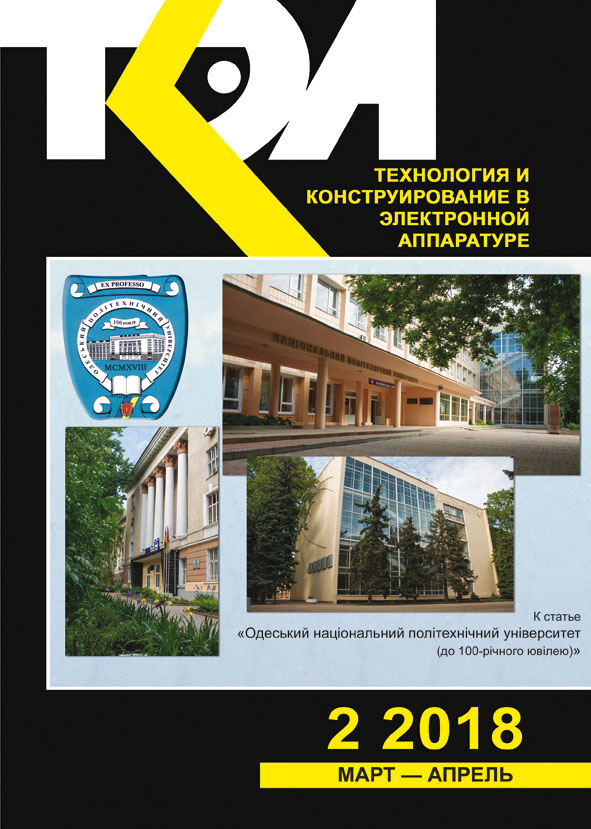Sensitivity of CCD matrices with electronic multiplication
Abstract
The sensitivity and basic electrical characteristics of the developed direct illumination matrices with charge-coupled devices and electronic multiplication were investigated at room temperatures and low illumination. Photomatrices of 576×288 and 640×512 format were designed using frame transfer architecture and 1.5-μm design rules with photosensitive cell sizes of 20×30 and 16×16 μm, respectively, and manufactured using n-channel technology with buried channel, four levels of polysilicon electrodes and two levels of metallization. To analyze the possibilities of the developed EMCCD matrices used in monitoring systems at low-light conditions, an experimental assessment of the matrices sensitivity was carried out. The assessment was based on a comparison of the luxmeter readings and Johnson's criteria using the standard 1951 USAF resolution target test table for the minimum size of line pairs distinguished by the observer (one pair consists of a dark and a light lines). The characteristics obtained with illumination of 5·10–4 lux (glow of the starry sky with light clouds) and 10–2 lux (glow of the starry sky and the quarter of the Moon) corresponds to the parameters of generation 2+ electron-optical converters, which implies the possibility to use such matrices in night vision devices. At Еv≈5·10–4 lux, the camera with the developed EMCCD matrices will detect a human figure at the distance of about 200 m. With illumination of 10–2 lux at this distance a human figure can be identified.
References
Gruzevich Yu. K. Optiko-elektronnye pribory nochnogo
videniyа [Optoelectronic night vision devices]. Moscow,
Fizmatlit, 2014, 276 p. (Rus)
Borissova D. Night Vision Devices. Sofia, Marin Drinov
Publishing House of Bulgarian Academy of Sciences, 2015.
Orlov V. A., Petrov V. I. Pribory nablyudeniyа noch’yu
pri ogranichennoi vidimosti [Observation devices at night with
reduced visibility]. Moscow, Voennoe izdatel’stvo, 1989. (Rus)
Salikov V. L. [Night Vision Devices: the History of Generations]. Spets. tekhnika, 2000, no. 2, pp. 40-48. (Rus)
https://www.hamamatsu.com/eu/en/technology/innovation/photocathode/index.html
Denvir D. J., Conroy E. Electron multiplying CCD technology: the new ICCD. Proc. SPIE, 2002, pp. 4796. http://dx.doi.org/10.1117/12.457779
Seitz P., Theuwissen A. J. P. Single-Photon Imaging, Springer, 2011, 354 p.
Daigle O. , Djazovski O. , Francoeur M., Laurin D. G. Doyon R. EMCCDs: 10 MHz and beyond. Proc. SPIE 9154, 91540B, 2014. http://dx.doi.org/10.1117/12.2054977
Wilkins A. N., McElwain M. W., Norton T. J. et al. Characterization of a photon counting EMCCD for spacebased high contrast imaging spectroscopy of extrasolar planets, Proc. SPIE 9154, 91540C, 2014. http://dx.doi.org/10.1117/12.2055346
Reva V. P., , Korinets S. V., Golenkov A. G., Sapon S. V., Torchinsky A. M., Zabudsky V. V., Sizov F. F. CCD photomatrixes with electron multiplication. Tekhnologiya i Konstruirovanie v Elektronnoi Apparature, no. 1-2, pp. 33-37. http://dx.doi.org/10.15222/TKEA2017.1-2.33 (Rus)
Borissova D. Night vision devices choice taking into account the external surveillance conditions. Advanced Modeling and Optimization, 2008, vol. 10, no. 2, pp. 213-220.
Derviere F. Quantum efficiency advances sensors for night vision. Euro Photonics, 2012.
Vatsia M. L. Atmospheric optical environment. United States, N. p., 1972. Web.
Tarasov V.V., Yаkushenkov Yu.G. Infrakrasnye sistemy smotryаshchego tipa [Infrared systems of the looking type]. Moscow, Logos, 2004, 452 p.
Copyright (c) 2018 F. F. Sizov, A. G. Golenkov, V. P. Reva, V. V. Zabudsky, S. V. Korinets, A. M. Torchinsky

This work is licensed under a Creative Commons Attribution 4.0 International License.

